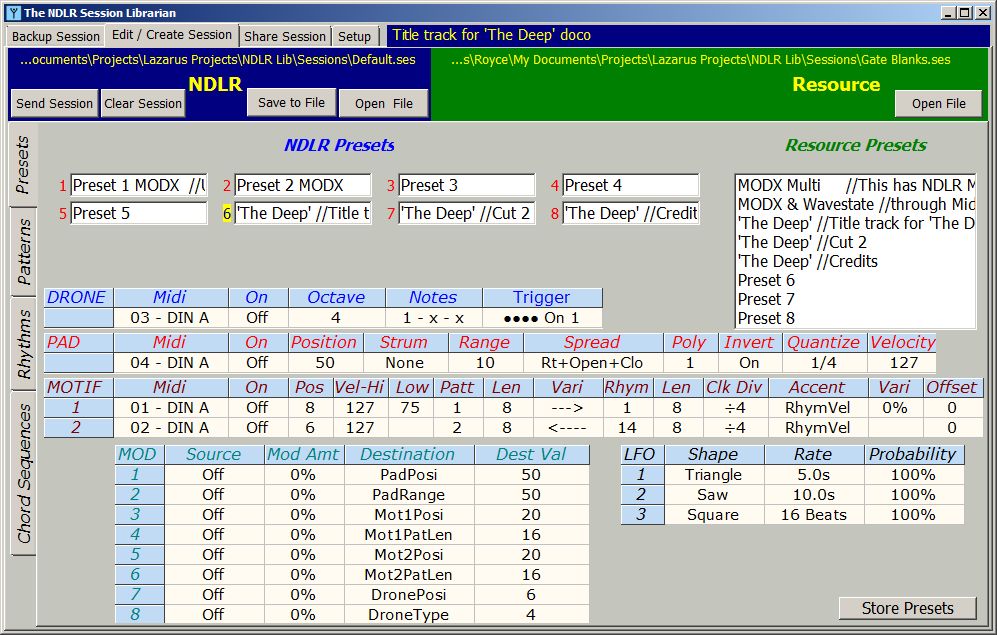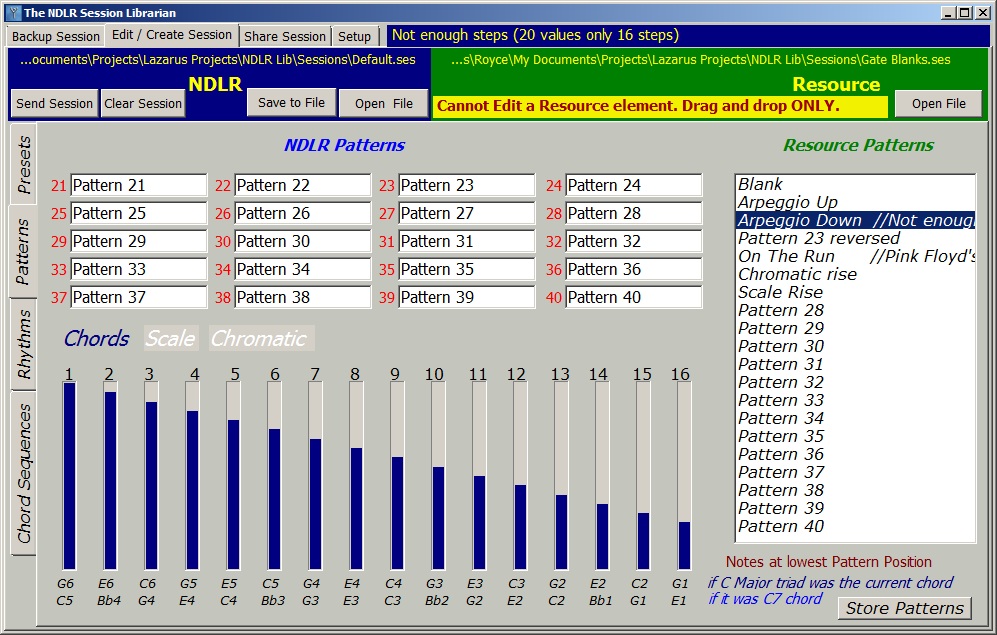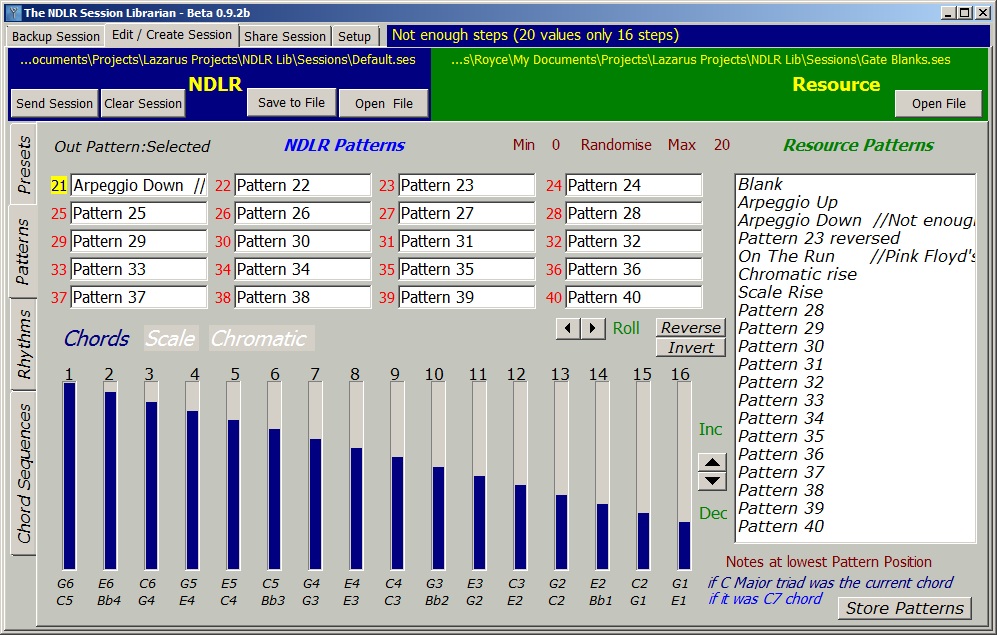Windows 64bit & 32bit Versions
NDLR Library for Windows version 1.0.4
NDLR Library version 1.0.4 for Windows.
Some new functions, some changes to mouse/key actions as well as a few bug fixes.
Run the program and press F1 to see a help page for the new Mouse and Key actions.
Make sure you check out the updated manual !
It has the changes for the new version at the front and revised information thoughout.
Here is the Linux version of the Library Program
Here is the Mac OSX version of the Library Program
The NDLR (Noodler) is a generative musical instrument from Conductive Labs.
If you are here, I guess, you either have one or at least know about this Midi sequencer.
This software not only allows you to take all your setups and programming of the NDLR and save it to disk for
backup, but also enables you to cut and paste elements to build new arrangements or patches or whatever you want to call it. Let's call it a 'Session'.
Although it is a Midi device, the communication and data retrieval is NOT by Midi's System exclusive,
but by USB high speed serial data and you'll need to get a driver (the link is below).
The Session is the whole of the user data in the NDLR and is made up of Presets, Patterns, Rhythms and Sequences.
In he library program there are two spaces to load a Session.
The main one is called the "NDLR Session" and is used to fetch and send the data to the NDLR and save to and load from computer files.
This is the ONLY session that can be edited.
The other session is called the "Resource Session" and is used as a source for drag and drop operations to build or rearrange elements in the NDLR Session.
The Resource Session CAN'T be edited.

The 'Backup' Page
This the starting page and you use this area to fetch the data from the NDLR and save it to a file.
Of course, once you have the Session file on disk, you can send it back to the NDLR and it stores it in the non-volatile memory (Flash memory).
Before you can use the software, you have to install a driver from pjrc for the "USB Virtual Serial Port"
https://www.pjrc.com/teensy/usb_serial.html
The Serial Port data is in addition to, and interdependent of, the four Midi Ports on the USB cable.
You also have to turn on the Serial data coming from the NDLR which is simple enough. (see Manual pdf in download)
The Editing Pages
Use the F1 help key to see the Mouse+Key combinations (hold it down to keep page open).
Use the F1 + CTRL to load the manual into your pdf reader.
On each of the following edit pages you can 'drag and drop' an element from the current NDLR Session or one or multiple elements from the Resource listbox.
Although you can name an element and add an extra message to each element, seeing the data displayed helps jogs the memory to what that element was used for. Making it easy to pick the right element to drag across.
The NDLR has a great, if somewhat small, graphic interface that is easy and quick to use, but for me, seeing all the data at once makes it simple to name, add some text or do the final tweaks before I save or send the session.
One of the exciting things about the NDLR, for me, is being able to use its encoders and buttons to change parameters and therefore the generated music, in real time.
It is improvising at the top level, calling out chord changes, tempo and other arranging stuff for your four (or more) piece band.
Because of the clever way the NDLR code is implemented, this is also true with much of what is in this Library program.
You can send a lot of values, a whole Pitch Pattern or Rhythm, to the buffer and the NDLR continues playing these new values without loosing a beat.
This has removed the limit on the number of available Patterns and Rhythms etc.
The 'Preset' Page
This is the main element (global data). There are eight Presets.
Not all the data is displayed, but enough for me to see what the Preset was used for.
This makes it easy to select the correct Preset when building a new session.

The 'Pattern' Page
The Patterns and the Rhythms are used for the two 'Motifs' (two of the four Midi generators).
There are 20 User 'Pitch' Patterns that can be written to flash.
You can click in the Resource listbox to see what the extra text is in the Resource file, BUT you can't edit it and so the edit tools are hidden or disabled.
In the picture below has none of the extra Motif Pattern editing features visible. You can make them visible in the Setup page.
This keeps the display less cluttered and may be all you want.

Selecting a Pattern in the "NDLR Session" puts the program into 'Edit Mode'.
In the picture below extra elements have been turned on in the Setup page.
The Randomisation and all of the extra Motif Pattern editing features are visible.
If you are interested in the extra editing tools, but can't see them, turn them on in the Setup tab.
Clicking on the 'Chord' or 'Scale' or 'Chromatic' label will change the Pattern to that form while keeping the contour the same.
You can Randomise within a value range or Invert (turn the Pattern shape upside down) or Reverse (play it backwards). Roll moves the whole pattern one step to the left or right.
Inc and Dec acts the same as NDLR's Pattern Position control. If you use it with the SHIFT key down, it compresses or expands the contour.
The mouse wheel is used a lot to edit, although the Left click (increase) or Right button click (decrease) works as well. Putting the cursor over a Step bar and rolling the mouse will change its value.
If you do it with the CTRL key pressed it will jump values.
Moving the mouse, with the SHIFT key, up and down the bar drags the value to where the cursor is. You can use this feature to quickly 'paint' a contour by SHIFT + moving the mouse across the bars.

The 'Rhythm' Page
A lot of the editing that you can do with the Patterns, you can also do with the Rhythms (see above).
The Gate varies the note length and is a special thing for the Rhythm page.
By placing a beat (Midi velocity value) then a lot of rests before the next non-zero velocity beat you can make a pseudo Gate function.
Sliding this bar left or right changes the tie to rest ratio, changing the beat from legato to staccato. I have included a Session file you can load into the Resource area to test this out.

The 'Sequencer' Page
The Sequencer is very straight forward and quick to edit on the NDLR, but I like seeing all the steps at once.
There are two 'heads up' tricks.
The first, if the 'length' (number of 1/4 notes) is 0 then the sequencer won't play this line and so I don't display any of the line in the table.
To make a blank line visible just change the '1/4 Notes' value.
The second is, if you want to see the sequence on the NDLR, you have to have that sequence (number 1 to 5, not 0) selected on the Chord Sequencer edit page on the NDLE (before or after you send the sequence to the NDLR).

A Special Extra Page

The 'Chord Builder' Page
While I was working out some stuff for the program I built a chord and scale table.
After finishing it I thought it might be useful for others, so here it is.
If there is space left in the NDLR, the guys from Conductive Labs said they would think about implementing user defined scales (which would be great).
I made the intervals editable while I was working, but I have hidden the mechanism to make a complicated table readable.
If User scales become a thing, I will add it back.
To download this copyright software you must agree not sell it or to distribute it in any way.
You must agree not to reverse engineer it in any way.
That being said, you may link here, www.bwalk.com.au, quite freely.
To Install the program:
Create a folder where you want to install the Library.
Open the Zip file (I use the free 7-ZIP)
Select and drag all the files and the 'Sessions' folder inside the Zip file to your new folder.
For the program to run, the NDLR_Lib.exe and Config.xml files need to be together in your created program directory and the Session files need to be in a sub-directory called 'Sessions' off the program directory.
Open the NDLR Library directory an ALT+click drag the NDLR_Lib.exe to your desktop to create a quick start icon.
To Remove the program:
Simply delete the program folder you created with all its contents and delete the quick start icon on your desktop..
Download Zip files here
(I used the free '7 Zip' to compress the files)
- NDLR_LibWIN64_1.0.4.zip, for 64 Bit versions of Windows- config and session files and a PDF Manual included
This is a native Windows 64bit version of the NDLR Library program.
To make sure this is the genuine file without errors...
you can use Windows command "CertUtil -hashfile NDLR_LibWIN64_1.0.4.zip SHA1",
OR you can use the new feature in 7-Zip:
Right click on the zip file and select 'CRC SHA' then 'SHA-1'
Name: NDLR_LibWIN64_1.0.4.zip
Size: 4134334 bytes (4037 KiB)
SHA1: 50D120E1413B6A06DAF53F6F856557ED0A7AE025
- NDLR_LibWIN32_1.0.4.zip, for 32 Bit versions of Windows- config and session files and a PDF Manual included
To make sure this is the genuine file without errors...
you can use Windows command "CertUtil -hashfile NDLR_LibWIN32_1.0.4.zip SHA1",
OR you can use the new feature in 7-Zip:
Right click on the zip file and select 'CRC SHA' then 'SHA-1'
Name: NDLR_LibWIN32_1.0.4.zip
Size: 3904850 bytes (3813 KiB)
SHA1: A59C49A6B95E892DD23015DB04CE51A269FF91D1
The Windows 32bit version of the NDLR Library program can run on 64bit Windows.
Right-click the link above and choose "Save Link As..." to save the zip file to your computer.
Click here to chat at Conductive Labs forum
I have used the program for a while now, but that doesn't mean there won't be a bug in it somewhere.
Let me know if you have any problems.
Feel free to suggest any improvements you think might be usefull.